Attractions · Europe · Going Out · Regions · Spain · Western Europe
UNESCO sites in Cordoba
Within 1.5 hours of home I can be in the centre of Cordoba and I often am. I’m lucky, I know. Cordoba is Andalusia’s most northern province. Vast swathes of sierras and pasture land used for the grazing of black pigs for Spain’s famous jamon meet the more northerly regions of Extremadura and Castilla-La Mancha.
It’s not to the natural areas that I’m taking you to today but the city. The historical city which is said to have been founded by the Phonenicians in the days when the huge River Guadalquivir could be navigated from the Atlantic Ocean as far as Cordoba.
 Under Roman occupation it flourished. Trading in olive oil, wool and minerals. Its riches were spent on building beautiful palaces and the enormous the Temple of Claudio Marcelo. After the decline of the Roman Empire in the fifth century, Vandals then Visigoths gained footholds before the city fell to the Moors around the 8th century.
Under Roman occupation it flourished. Trading in olive oil, wool and minerals. Its riches were spent on building beautiful palaces and the enormous the Temple of Claudio Marcelo. After the decline of the Roman Empire in the fifth century, Vandals then Visigoths gained footholds before the city fell to the Moors around the 8th century.
 It’s the legacy of the Moors, Cordoba’s golden years, that we see today. The time when Cordoba city formed the Western Islamic Empire which rivalled Cairo and Baghdad as a centre of Muslim art and learning. These legacies, which are now protected by UNESCO as World Heritage Sites are the main reason I keep on returning to my neighbouring city.
Cordoba’s UNESCO Sites
There are four UNESCO sites in Cordoba more than any other city in Spain, or indeed any other area of the world. So why isn’t Cordoba the most visited city? It is one of Andalusia’s top three cities but many people associate Cordoba with the Mezquita and the Mezquita as Cordoba.
In ‘my’ province of Jaen I have a holiday home. Many foreigners visit precisely because of the location to be able to visit Cordoba and The Mezquita one day and Granada and The Alhambra the next. Nothing much more than these two, incredibly worthy of visiting, monuments are seen. Take your time. See the cities. Inhale the history. Stop a while and picture the times when these incredible buildings were inhabited.
The four UNESCO sites in Cordoba that you must see are:
Medina Azahara
Once a splendid city which took twenty-five years to build, the Medina Azahara oozed marble, jasper and precious metals. In 936 Caliph Abd al-Rahman started to establish a city about 7km west of the Cordoba. An area where the rich, since Roman times, had traditionally established their country homes. Now it’s a museum and archaelogical site that has to be seen.
It’s the legacy of the Moors, Cordoba’s golden years, that we see today. The time when Cordoba city formed the Western Islamic Empire which rivalled Cairo and Baghdad as a centre of Muslim art and learning. These legacies, which are now protected by UNESCO as World Heritage Sites are the main reason I keep on returning to my neighbouring city.
Cordoba’s UNESCO Sites
There are four UNESCO sites in Cordoba more than any other city in Spain, or indeed any other area of the world. So why isn’t Cordoba the most visited city? It is one of Andalusia’s top three cities but many people associate Cordoba with the Mezquita and the Mezquita as Cordoba.
In ‘my’ province of Jaen I have a holiday home. Many foreigners visit precisely because of the location to be able to visit Cordoba and The Mezquita one day and Granada and The Alhambra the next. Nothing much more than these two, incredibly worthy of visiting, monuments are seen. Take your time. See the cities. Inhale the history. Stop a while and picture the times when these incredible buildings were inhabited.
The four UNESCO sites in Cordoba that you must see are:
Medina Azahara
Once a splendid city which took twenty-five years to build, the Medina Azahara oozed marble, jasper and precious metals. In 936 Caliph Abd al-Rahman started to establish a city about 7km west of the Cordoba. An area where the rich, since Roman times, had traditionally established their country homes. Now it’s a museum and archaelogical site that has to be seen.
 The historic centre of Cordoba
I always drive to Cordoba and park (for free) then walk over the enormous pedestrian Roman Bridge. Leaving the Torre Fortaleza de la Calahorra protecting one side of the bridge which straddles the River Guadalquivir and walking towards the Mezquita and the Alcázar de los Reyes Cristianos has to be the best view in Cordoba. All of which, together with the maze of narrow streets of the Jewish Quarter around the Mezquita, form the historical quarter.
The historic centre of Cordoba
I always drive to Cordoba and park (for free) then walk over the enormous pedestrian Roman Bridge. Leaving the Torre Fortaleza de la Calahorra protecting one side of the bridge which straddles the River Guadalquivir and walking towards the Mezquita and the Alcázar de los Reyes Cristianos has to be the best view in Cordoba. All of which, together with the maze of narrow streets of the Jewish Quarter around the Mezquita, form the historical quarter.
 This complex of streets home to communal houses surrounding inner patios, originally Roman then Moorish are the host of our next UNESCO listing
The Great Mosque of Cordoba
Started by Abd ar-Rahman l, 30 years after the conquest which began the domination of Moorish Spain in 792, The Mezquita is astounding. Great in name and in structure. On my first visit which was near the end of the day, a time I recommend you visit, there was one other couple, several security guards and me. Overwhelming and enormous. Silence prevailed and I was touched to the core. Subsequent visits with family and at busier times of the day when bus loads of tourists are present sadly detracted greatly from the experience.
This complex of streets home to communal houses surrounding inner patios, originally Roman then Moorish are the host of our next UNESCO listing
The Great Mosque of Cordoba
Started by Abd ar-Rahman l, 30 years after the conquest which began the domination of Moorish Spain in 792, The Mezquita is astounding. Great in name and in structure. On my first visit which was near the end of the day, a time I recommend you visit, there was one other couple, several security guards and me. Overwhelming and enormous. Silence prevailed and I was touched to the core. Subsequent visits with family and at busier times of the day when bus loads of tourists are present sadly detracted greatly from the experience.
 Cordoba Patio Festival
Festivals are declared world heritages when they’re ‘deemed particularly notable’ This festival of flowers started in 1918 and was added to the World Heritage list in 2012. These days visiting the patios involves a lot of queueing. Each one is uniquely decorated, brightly coloured flowering shrubs spill out of borders and potted geraniums which survive the intense heat from one watering to the next. With camera in hand it’s often difficult to take photos without people getting in the way but I’ll be there yet again this May.
Cordoba Patio Festival
Festivals are declared world heritages when they’re ‘deemed particularly notable’ This festival of flowers started in 1918 and was added to the World Heritage list in 2012. These days visiting the patios involves a lot of queueing. Each one is uniquely decorated, brightly coloured flowering shrubs spill out of borders and potted geraniums which survive the intense heat from one watering to the next. With camera in hand it’s often difficult to take photos without people getting in the way but I’ll be there yet again this May.

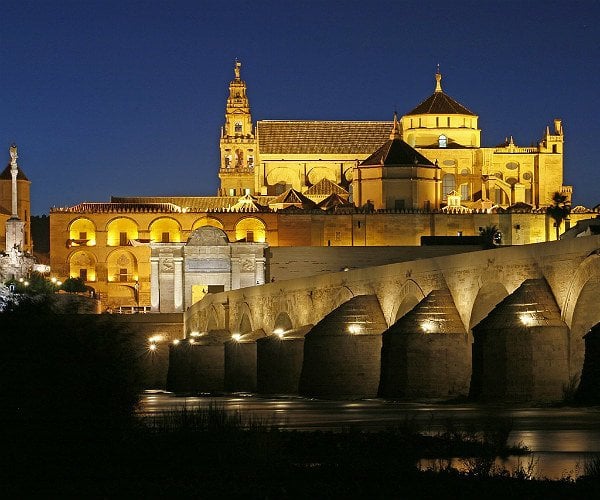 Under Roman occupation it flourished. Trading in olive oil, wool and minerals. Its riches were spent on building beautiful palaces and the enormous the Temple of Claudio Marcelo. After the decline of the Roman Empire in the fifth century, Vandals then Visigoths gained footholds before the city fell to the Moors around the 8th century.
Under Roman occupation it flourished. Trading in olive oil, wool and minerals. Its riches were spent on building beautiful palaces and the enormous the Temple of Claudio Marcelo. After the decline of the Roman Empire in the fifth century, Vandals then Visigoths gained footholds before the city fell to the Moors around the 8th century.
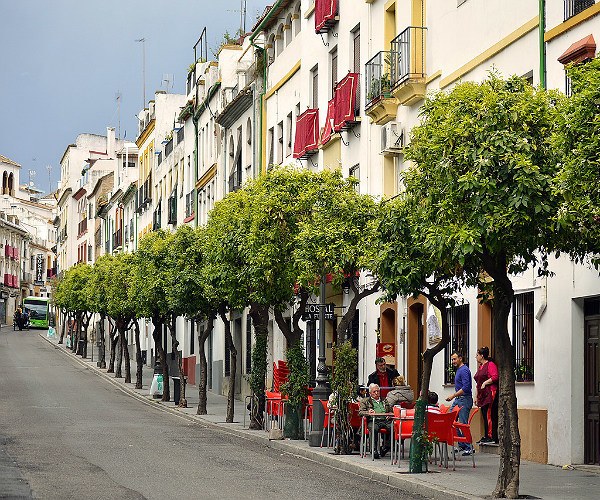 It’s the legacy of the Moors, Cordoba’s golden years, that we see today. The time when Cordoba city formed the Western Islamic Empire which rivalled Cairo and Baghdad as a centre of Muslim art and learning. These legacies, which are now protected by UNESCO as World Heritage Sites are the main reason I keep on returning to my neighbouring city.
Cordoba’s UNESCO Sites
There are four UNESCO sites in Cordoba more than any other city in Spain, or indeed any other area of the world. So why isn’t Cordoba the most visited city? It is one of Andalusia’s top three cities but many people associate Cordoba with the Mezquita and the Mezquita as Cordoba.
In ‘my’ province of Jaen I have a holiday home. Many foreigners visit precisely because of the location to be able to visit Cordoba and The Mezquita one day and Granada and The Alhambra the next. Nothing much more than these two, incredibly worthy of visiting, monuments are seen. Take your time. See the cities. Inhale the history. Stop a while and picture the times when these incredible buildings were inhabited.
The four UNESCO sites in Cordoba that you must see are:
Medina Azahara
Once a splendid city which took twenty-five years to build, the Medina Azahara oozed marble, jasper and precious metals. In 936 Caliph Abd al-Rahman started to establish a city about 7km west of the Cordoba. An area where the rich, since Roman times, had traditionally established their country homes. Now it’s a museum and archaelogical site that has to be seen.
It’s the legacy of the Moors, Cordoba’s golden years, that we see today. The time when Cordoba city formed the Western Islamic Empire which rivalled Cairo and Baghdad as a centre of Muslim art and learning. These legacies, which are now protected by UNESCO as World Heritage Sites are the main reason I keep on returning to my neighbouring city.
Cordoba’s UNESCO Sites
There are four UNESCO sites in Cordoba more than any other city in Spain, or indeed any other area of the world. So why isn’t Cordoba the most visited city? It is one of Andalusia’s top three cities but many people associate Cordoba with the Mezquita and the Mezquita as Cordoba.
In ‘my’ province of Jaen I have a holiday home. Many foreigners visit precisely because of the location to be able to visit Cordoba and The Mezquita one day and Granada and The Alhambra the next. Nothing much more than these two, incredibly worthy of visiting, monuments are seen. Take your time. See the cities. Inhale the history. Stop a while and picture the times when these incredible buildings were inhabited.
The four UNESCO sites in Cordoba that you must see are:
Medina Azahara
Once a splendid city which took twenty-five years to build, the Medina Azahara oozed marble, jasper and precious metals. In 936 Caliph Abd al-Rahman started to establish a city about 7km west of the Cordoba. An area where the rich, since Roman times, had traditionally established their country homes. Now it’s a museum and archaelogical site that has to be seen.
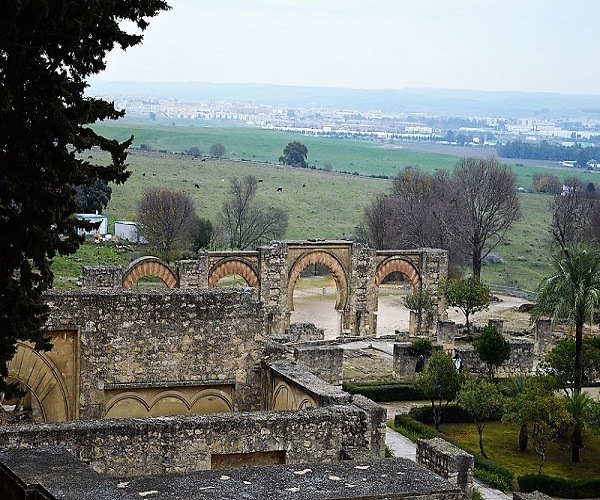 The historic centre of Cordoba
I always drive to Cordoba and park (for free) then walk over the enormous pedestrian Roman Bridge. Leaving the Torre Fortaleza de la Calahorra protecting one side of the bridge which straddles the River Guadalquivir and walking towards the Mezquita and the Alcázar de los Reyes Cristianos has to be the best view in Cordoba. All of which, together with the maze of narrow streets of the Jewish Quarter around the Mezquita, form the historical quarter.
The historic centre of Cordoba
I always drive to Cordoba and park (for free) then walk over the enormous pedestrian Roman Bridge. Leaving the Torre Fortaleza de la Calahorra protecting one side of the bridge which straddles the River Guadalquivir and walking towards the Mezquita and the Alcázar de los Reyes Cristianos has to be the best view in Cordoba. All of which, together with the maze of narrow streets of the Jewish Quarter around the Mezquita, form the historical quarter.
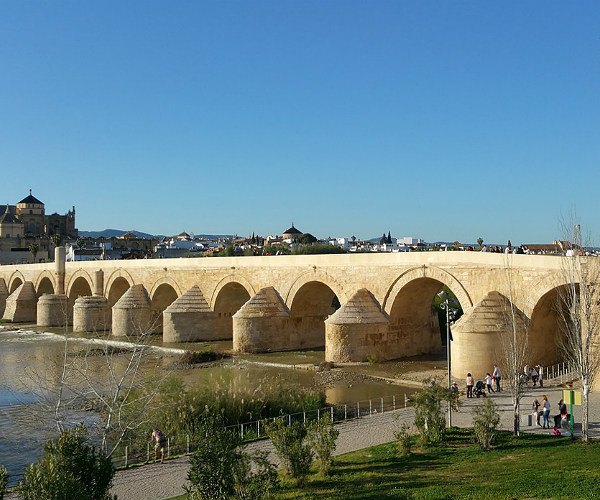 This complex of streets home to communal houses surrounding inner patios, originally Roman then Moorish are the host of our next UNESCO listing
The Great Mosque of Cordoba
Started by Abd ar-Rahman l, 30 years after the conquest which began the domination of Moorish Spain in 792, The Mezquita is astounding. Great in name and in structure. On my first visit which was near the end of the day, a time I recommend you visit, there was one other couple, several security guards and me. Overwhelming and enormous. Silence prevailed and I was touched to the core. Subsequent visits with family and at busier times of the day when bus loads of tourists are present sadly detracted greatly from the experience.
This complex of streets home to communal houses surrounding inner patios, originally Roman then Moorish are the host of our next UNESCO listing
The Great Mosque of Cordoba
Started by Abd ar-Rahman l, 30 years after the conquest which began the domination of Moorish Spain in 792, The Mezquita is astounding. Great in name and in structure. On my first visit which was near the end of the day, a time I recommend you visit, there was one other couple, several security guards and me. Overwhelming and enormous. Silence prevailed and I was touched to the core. Subsequent visits with family and at busier times of the day when bus loads of tourists are present sadly detracted greatly from the experience.
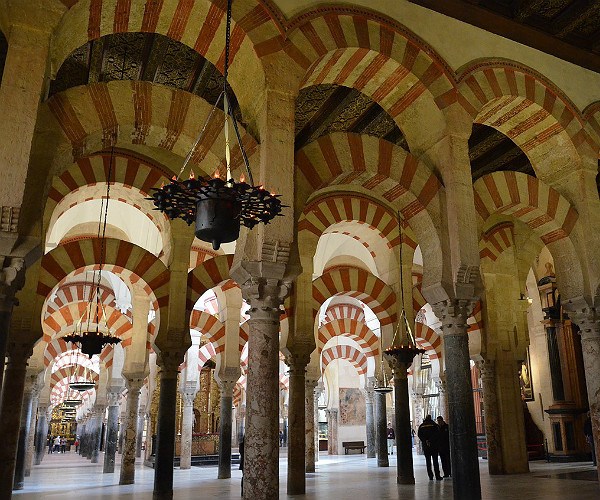 Cordoba Patio Festival
Festivals are declared world heritages when they’re ‘deemed particularly notable’ This festival of flowers started in 1918 and was added to the World Heritage list in 2012. These days visiting the patios involves a lot of queueing. Each one is uniquely decorated, brightly coloured flowering shrubs spill out of borders and potted geraniums which survive the intense heat from one watering to the next. With camera in hand it’s often difficult to take photos without people getting in the way but I’ll be there yet again this May.
Cordoba Patio Festival
Festivals are declared world heritages when they’re ‘deemed particularly notable’ This festival of flowers started in 1918 and was added to the World Heritage list in 2012. These days visiting the patios involves a lot of queueing. Each one is uniquely decorated, brightly coloured flowering shrubs spill out of borders and potted geraniums which survive the intense heat from one watering to the next. With camera in hand it’s often difficult to take photos without people getting in the way but I’ll be there yet again this May.
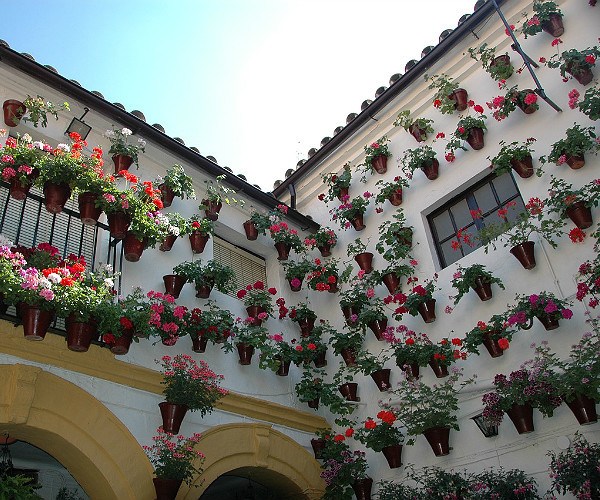
Did you enjoy this article?
Receive similar content direct to your inbox.


I’ve found that first thing in the morning is another good time to visit the Mezquita. When I visited admission was free for the first hour and having got there about fifteen minutes before opening there were just around two dozen people in the queue. Once the doors were opened the Mezquita soon swallowed them up. Also early in the morning the rising sunlight casts interesting patterns through all those columns.
Perhaps the most remarkable thing about the Mezquita is that it exists at all. After battling the Moors for centuries for the Reconquest of Spain, the Spanish army did not destroy the Mosque but repurposed it as a Christian cathedral, showing remarkable tolerance from the people who launched the Spanish Inquisition (twice.)
As I live quite near it is rare that I’m there first thing in the morning, but I imagine the light is stunning then.
I am visiting a hotel very near the Mezquita in a couple of weeks so I will go early. Thank you for the suggestion.
Rachel
Man can not live on art and architecture alone. Yes, Cordoba has got some fantastic historic monuments but there can be few better places in Spain to have to feed yourself.
Cordoba is doing it’s very best to lead Spain’s culinary crusade. However experienced a tapas eater you are I can guarantee that Cordoba’s chefs will create a few gourmet tapas that you will never have experienced before. Wine’s not bad either…
I absolutely agree. One can’t appreciate all the art and architecture without being well fed and watered. Cordoba has some excellent restaurants and wines.
A couple of years ago I fully intended to do the great Spanish trio of Granada, Seville and Cordoba. I had no plans other than a flight home for Seville after 8 days.
Seville was brilliant and Granada even more brilliant and sadly I never got round to Cordoba. Reading this post I’ve realised how much I missed out on and next time I’ll start with Cordoba.
The great trio are really great, but only part or 3/8 of Andalucia -3 cities out of the 8 that make up Andalucia and then there are hundreds are great towns that need visiting too.
It’s a shame you missed out on Cordoba, as both are 1,5 hours from my home I’m passionate about both and would find it extremely difficult to decide which I prefer.
Although it is far from a UNESCO sight if you are in Cordoba when the huge market is on it is well worth a visit to get a feel for Cordoba’s people. The market is very bright, almost gaudy with all the vivid colours. There’s some real local colour with buckets of live snails where you can pick your own lunch or dinner.
Love the comment .. very bright, almost gaudy! I think that sums up Andalusia in the heat of summer extremely well!
I have to admit I have never been to the market in Cordoba, you have piqued my interest. I’m off to find out what day it is on. I guess it won’t be Sunday or Monday when I’m there next! Oh well, that means another trip! Thanks for your comment, I will check it out but might leave the live snails exactly where they are!
Rachel
UNESCO has a really high standard when it comes to picking heritage sites and that’s why these places are worth a visit when you travel to Spain for your vacation. I have been to a few famous UNESCO sites and most of them are in Asia, particularly in the Philippines. I’ve visited the famous Puerto-Princesa Subterranean River National Park which is also included in the New Seven Wonders of Nature list. Although, I have been wondering if these places are accepting visitors in these times and I don’t know what the quarantine protocols in Europe or in Spain are. I know for a fact that other countries such as Iceland, are open for visitors but tourists must comply with their protocol of being in quarantine for atleast a week before being able to travel the country freely. I hope that Europe also has the same sort of plan in order to limit the spread of the virus and practice social distancing.